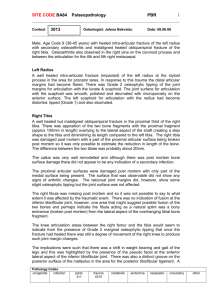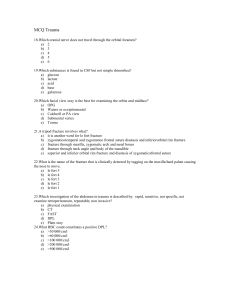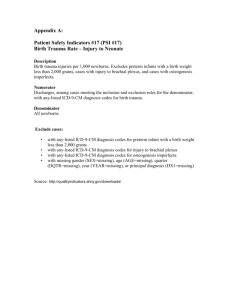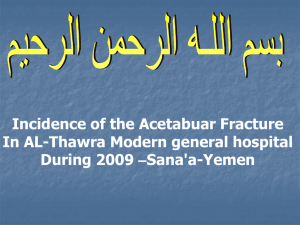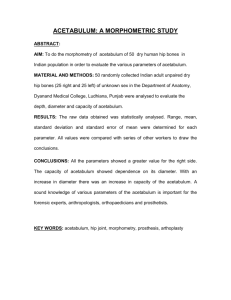3274 - Museum of London
advertisement
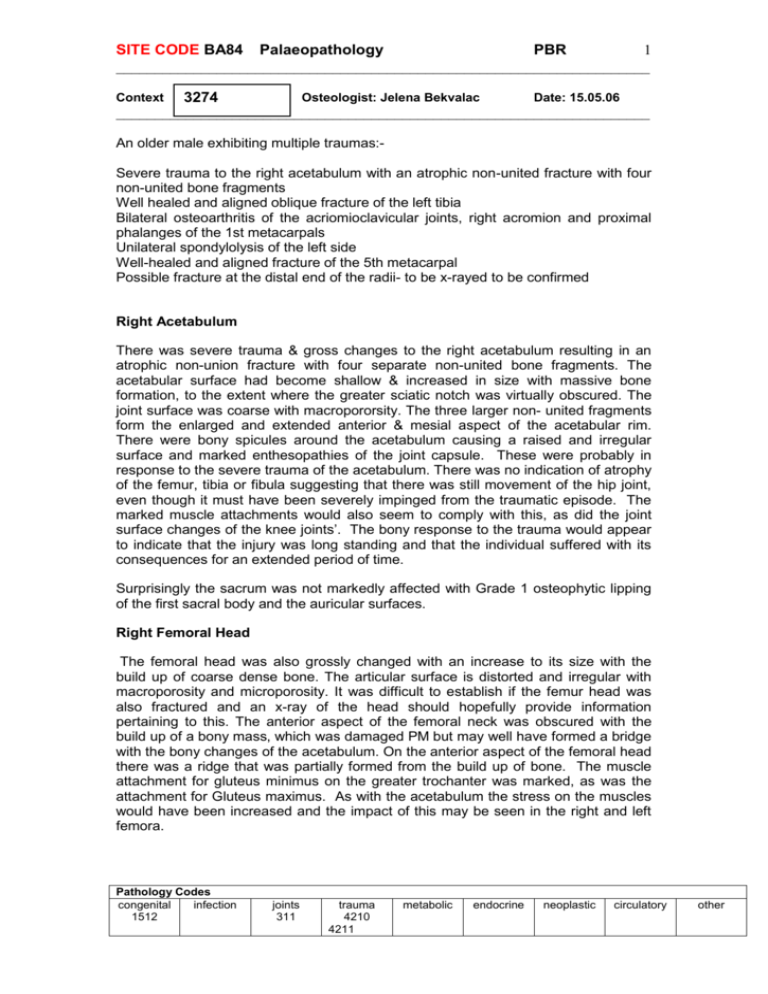
1 SITE CODE BA84 Palaeopathology PBR _____________________________________________________________________ Osteologist: Jelena Bekvalac Date: 15.05.06 3274 _____________________________________________________________________ Context An older male exhibiting multiple traumas:Severe trauma to the right acetabulum with an atrophic non-united fracture with four non-united bone fragments Well healed and aligned oblique fracture of the left tibia Bilateral osteoarthritis of the acriomioclavicular joints, right acromion and proximal phalanges of the 1st metacarpals Unilateral spondylolysis of the left side Well-healed and aligned fracture of the 5th metacarpal Possible fracture at the distal end of the radii- to be x-rayed to be confirmed Right Acetabulum There was severe trauma & gross changes to the right acetabulum resulting in an atrophic non-union fracture with four separate non-united bone fragments. The acetabular surface had become shallow & increased in size with massive bone formation, to the extent where the greater sciatic notch was virtually obscured. The joint surface was coarse with macropororsity. The three larger non- united fragments form the enlarged and extended anterior & mesial aspect of the acetabular rim. There were bony spicules around the acetabulum causing a raised and irregular surface and marked enthesopathies of the joint capsule. These were probably in response to the severe trauma of the acetabulum. There was no indication of atrophy of the femur, tibia or fibula suggesting that there was still movement of the hip joint, even though it must have been severely impinged from the traumatic episode. The marked muscle attachments would also seem to comply with this, as did the joint surface changes of the knee joints’. The bony response to the trauma would appear to indicate that the injury was long standing and that the individual suffered with its consequences for an extended period of time. Surprisingly the sacrum was not markedly affected with Grade 1 osteophytic lipping of the first sacral body and the auricular surfaces. Right Femoral Head The femoral head was also grossly changed with an increase to its size with the build up of coarse dense bone. The articular surface is distorted and irregular with macroporosity and microporosity. It was difficult to establish if the femur head was also fractured and an x-ray of the head should hopefully provide information pertaining to this. The anterior aspect of the femoral neck was obscured with the build up of a bony mass, which was damaged PM but may well have formed a bridge with the bony changes of the acetabulum. On the anterior aspect of the femoral head there was a ridge that was partially formed from the build up of bone. The muscle attachment for gluteus minimus on the greater trochanter was marked, as was the attachment for Gluteus maximus. As with the acetabulum the stress on the muscles would have been increased and the impact of this may be seen in the right and left femora. Pathology Codes congenital infection 1512 joints 311 trauma 4210 4211 metabolic endocrine neoplastic circulatory other 2 SITE CODE BA84 Palaeopathology PBR _____________________________________________________________________ Osteologist: Jelena Bekvalac Date: 15.05.06 3274 _____________________________________________________________________ Context Vertebrae There was osteophytic lipping of the cervical, thoracic and lumbar vertebrae but the lipping became more severe in the lumbar vertebrae and may be associated with the trauma to the left tibia and right acetabulum. The anterior surface of L2 and L3 had bony outgrowths in the region of the anterior spinal ligament. L2 also had the appearance of being reduced and diminished in height, which may be associated with the changes on the anterior surface. It may also be linked to the trauma of the right hip and left tibia. Right 5th Metacarpal A well-healed and aligned oblique fracture of the right 5th metacarpal at the distal end. The distal joint surface had become slightly distorted with a smooth bony tubercle, myostisis ossificans on the ventral surface and a smooth bony eminence from the medial shaft surface. The joint surface had not been affected and only in part had Grade 1 osteophytic lipping. Left and Right Radii Possible bilateral fracture of the radii at the distal end in the area most commonly associated with a Colles fracture. There was a transverse line of slightly raised bone that may have been an indication of a fracture. If not a complete fracture then possibly they were hairline fractures indicating stress. Either resulting from the trauma to the right hip and left tibia or from pressure placed on the arms subsequently from the trauma. The weight of load bearing when this individual walked would have been markedly changed in this individual and shifted two fold because of the shortening of the left tibia from the fracture and further from the severe trauma to the right hip joint. This was seen further seen in the changes to the lumbar vertebrae and the bilateral osteoarthritis of the acromioclavicular joints. If the individual was placing more weight upon their arms this may have contributed to the osteoarthritis. Pathology Codes congenital infection 1512 joints 311 trauma 4210 4211 metabolic endocrine neoplastic circulatory other
